Numerical Investigation on the Flow Characteristics in a 17 × 17 Full-Scale Fuel Assembly
Abstract
1. Introduction
2. Mathematical Model
3. Geometric Model
4. Mesh and Turbulence Model Verification
4.1. Mesh Independence Investigation
4.2. Turbulence Model Verification
4.3. Mesh Generation for the Whole Fuel Assembly
4.4. Boundary Conditions and Calculations
5. Results and Discussion
5.1. Pressure Verification
5.2. Velocity Distrubution
5.3. Temperature Distribution
6. Conclusions
- In the Star-CCM+ software, the full-scale fuel assembly could be simulated and analyzed using using polyhedral and extruded meshes. The total number of meshes for the complete fuel assembly was 193 million. The mesh model was verified using independent verification and the SST turbulence model was verified by small-scale experiments.
- The results of the pressure drop in the whole fuel assembly was verified by the integer hydraulic test data of the fuel assembly. The calculation and experiment pressure drop difference was less than 10%.
- The difference in the axial velocity between the different sub-channels occurred only when the rod region downstream of the grid was longer. On the contrary, the lateral velocity in the control rod sub-channel was clearly higher than that in other channels, which was caused by the generation and migration of different vortexes in the sub-channels.
- There was a velocity shadow at local positions near the wall, resulting in an uneven local temperature distribution, and even produced hot spots. The presence of the spacer grid had a significant effect on the maximum temperature of the fluid near the fuel rod wall, but had little effect on the minimum temperature.
Author Contributions
Funding
Conflicts of Interest
References
- McClusky, H.L.; Holloway, M.V.; Conover, T.A.; Beasley, D.E.; Conner, M.E.; Smith, L.D. Mapping of the lateral flow field in typical sub-channels of a support grid with vanes. J. Fluids Eng. 2003, 125, 987. [Google Scholar] [CrossRef]
- Holloway, M.V.; McClusky, H.L.; Beasley, D.E.; Conner, M.E. The effect of support grid features on local, single-phase heat transfer measurements in rod bundles. J. Heat Transf. 2004, 126, 43. [Google Scholar] [CrossRef]
- Holloway, M.V.; Conover, T.A.; McClusky, H.L.; Beasley, D.E.; Conner, M.E. The effect of support grid design on azimuthal variation in heat transfer coefficient for rod bundles. J. Heat Transf. 2005, 127, 598. [Google Scholar] [CrossRef]
- Conner, M.E.; Baglietto, E.; Elmahdi, A.M. CFD methodology and validation for single-phase flow in PWR fuel assemblies. Nucl. Eng. Des. 2010, 240, 2088–2095. [Google Scholar] [CrossRef]
- Karoutas, Z.; Gu, C.Y. 3-D flow analyses for design of nuclear fuel spacer. In Proceedings of the Seventh International Meeting on Nuclear Reactor Thermal-Hydraulics, New York, NY, USA, 10–15 September 1995. [Google Scholar]
- Seok, K.C.; Sang, K.M.; Won, P.B.; Young, D.C. Phenomenological investigations on the turbulent flow structures in a rod bundle array with mixing devices. Nucl. Eng. Des. 2008, 238, 600–609. [Google Scholar]
- Sang, Y.H.; Jeong, S.S.; Min, S.P.; Young, D.C. Measurements of the flow characteristics of the lateral flow in the 6 × 6 rod bundles with Tandem Arrangement Vanes. Nucl. Eng. Des. 2009, 239, 2728–2736. [Google Scholar]
- Conner, M.E.; Hassan, Y.A.; Dominguez-Ontiveros, E.E. Hydraulic benchmark data for PWR mixing vane grid. Nucl. Eng. Des. 2013, 264, 97–102. [Google Scholar] [CrossRef]
- Wang, K.I.; Dong, S.O.; Tae, H.C. Flow Analysis for Optimum Design of Mixing Vane in a PWR Fuel Assembly. J. Korean Nucl. Soc. 2001, 33, 327–338. [Google Scholar]
- Cui, X.Z.; Kim, K.Y. Three Dimensional Analysis of Turbulent Heat Transfer and Flow through Mixing Vane in A sub-channel of Nuclear Reactor. J. Nucl. Sci. Technol. 2003, 40, 719–724. [Google Scholar] [CrossRef]
- Holloway, M.V.; Beasley, D.E.; Conner, M.E. Investigation of swirling flow in rod bundle sub-channels using computation fluid dynamics. In Proceedings of the ICONE 14 International Conference on Nuclear Engineering, Miami, FL, USA, 17–20 July 2006. [Google Scholar]
- Nematollahi, M.R.; Nazifi, M. Enhancement of heat transfer in a typical pressurized water reactor by different mixing vanes on spacer grids. Energy Convers. Manag. 2008, 49, 1981–1988. [Google Scholar] [CrossRef]
- Yan, B.H.; Gu, H.Y.; Yang, Y.H.; Yu, L. Effect of rolling on the flowing and heat transfer characteristic of turbulent flow in sub-channels. Prog. Nucl. Energy 2011, 53, 59–65. [Google Scholar] [CrossRef]
- Liu, C.C.; Ferng, Y.M.; Shih, C.K. CFD evaluation of turbulence models for flow simulation of the fuel rod bundle with a spacer assembly. Appl. Therm. Eng. 2012, 40, 389–396. [Google Scholar] [CrossRef]
- Ikeno, T.; Kajishima, T. Analysis of dynamical flow structure in a square arrayed rod bundle. Nucl. Eng. Des. 2010, 240, 305–312. [Google Scholar] [CrossRef]
- Bae, J.H.; Park, J.H. Analytical prediction of turbulent friction factor for a rod bundle. Ann. Nucl. Energy 2011, 38, 348–357. [Google Scholar] [CrossRef]
- Li, Q.; Chen, J.; Jiao, Y.H. Research on Resistance Features of a 5 × 5 Rod Bundle with Spacer Grid. Nucl. Power Eng. 2015, 36, 28–32. [Google Scholar]

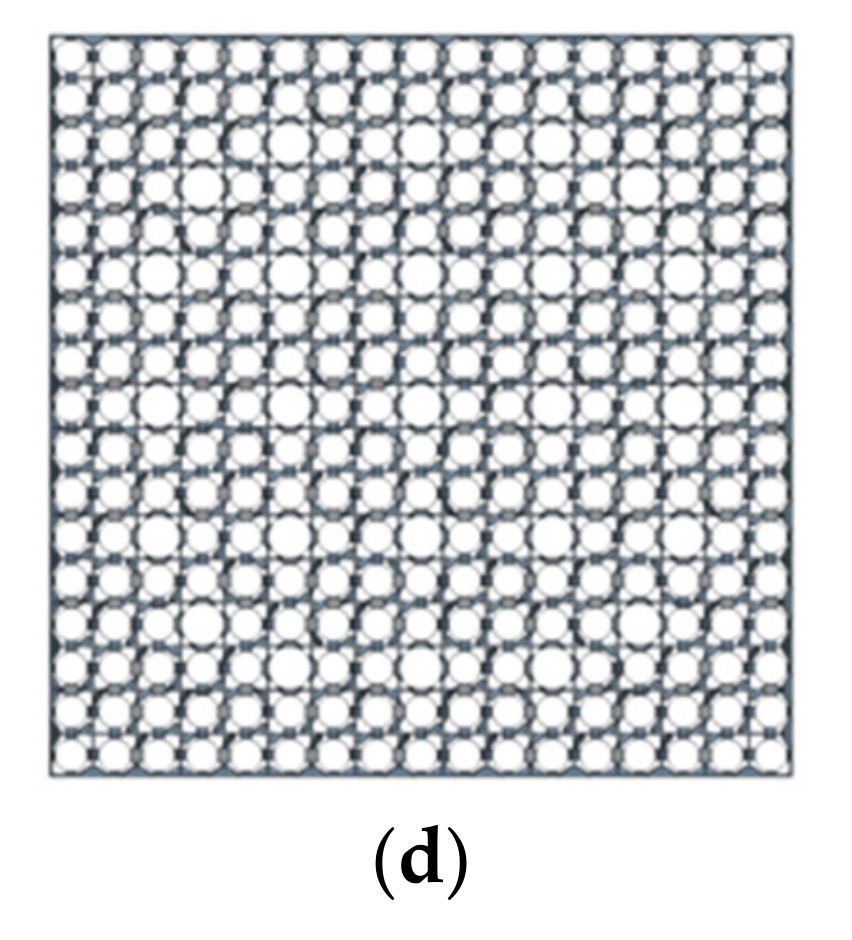



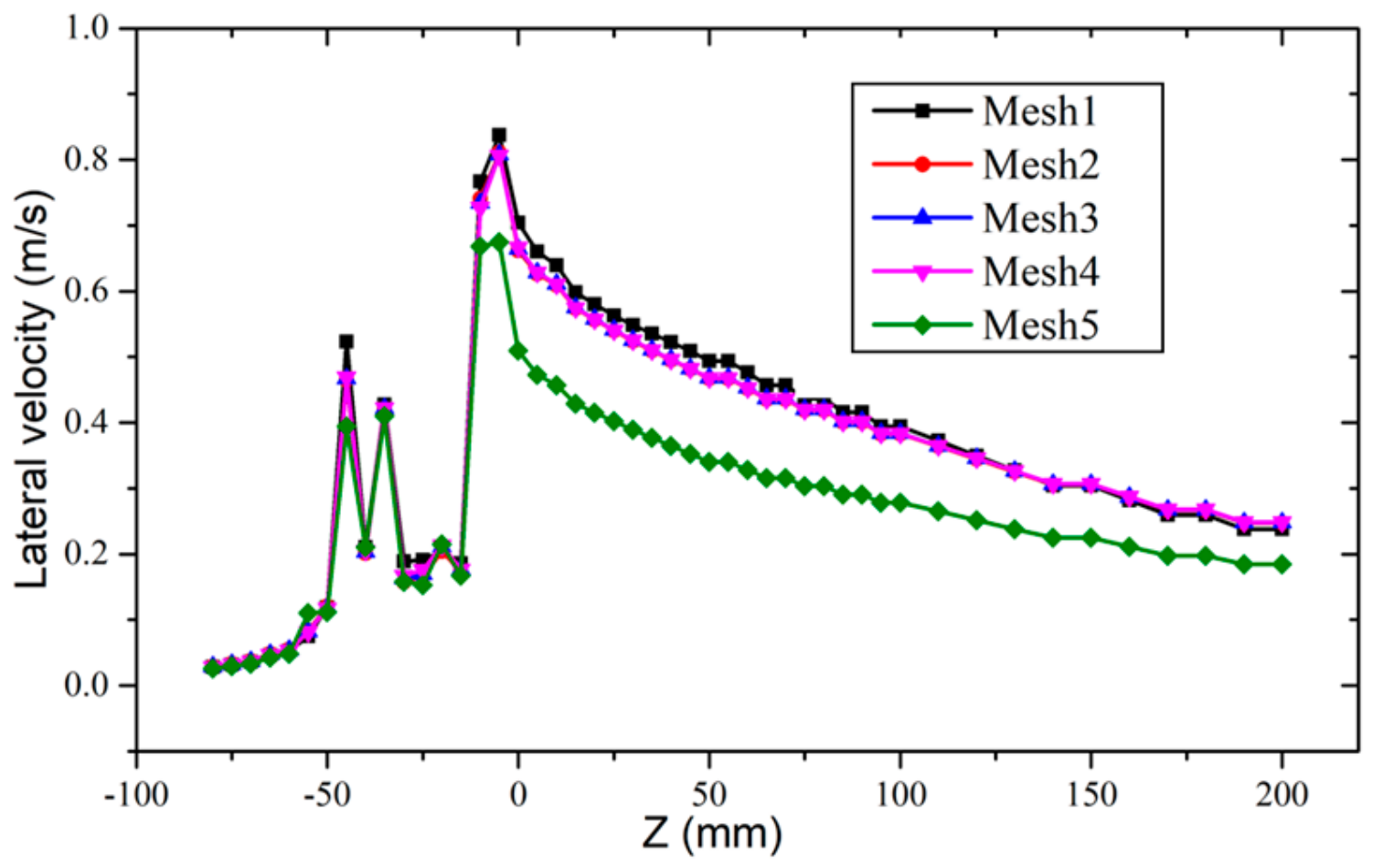
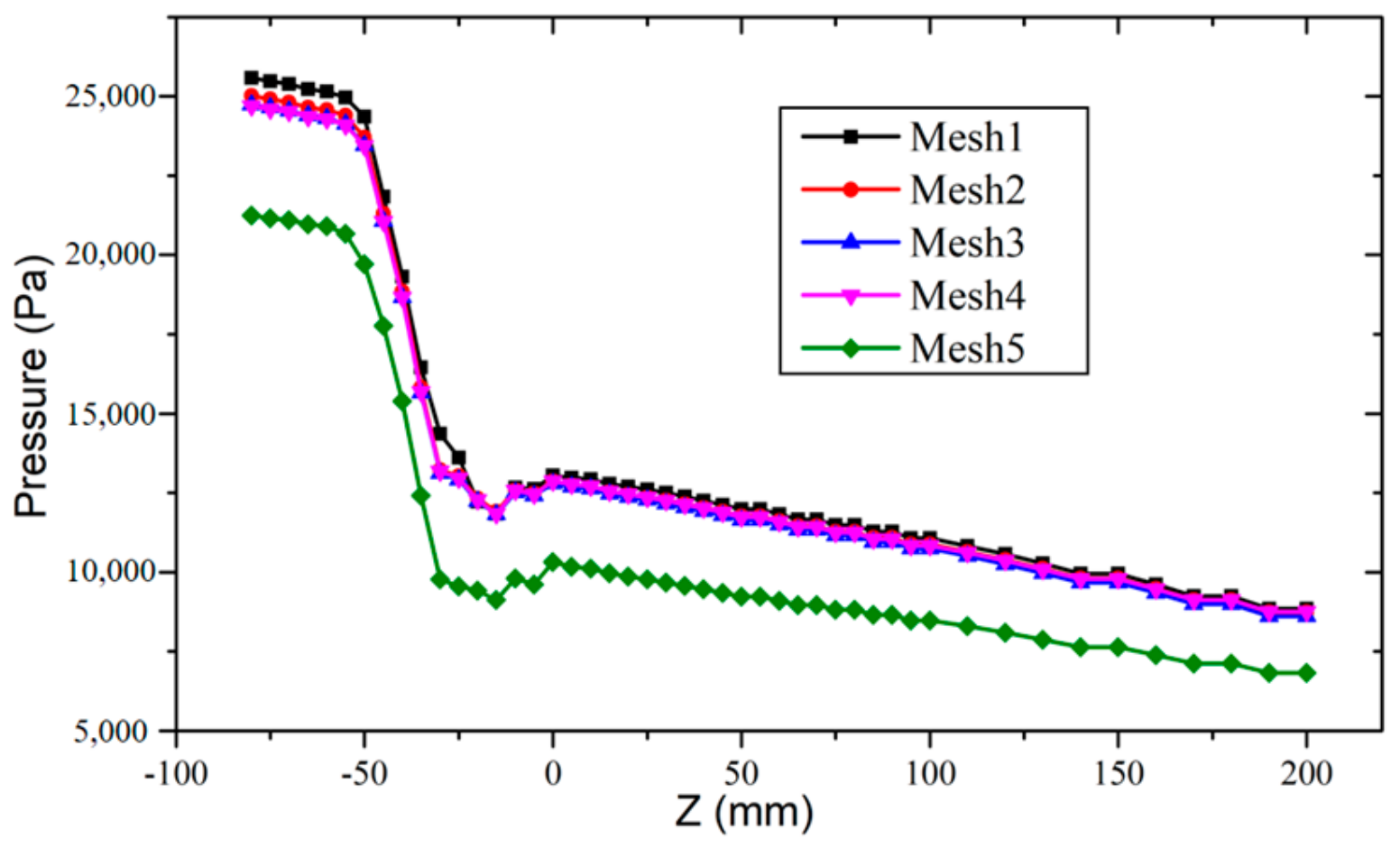
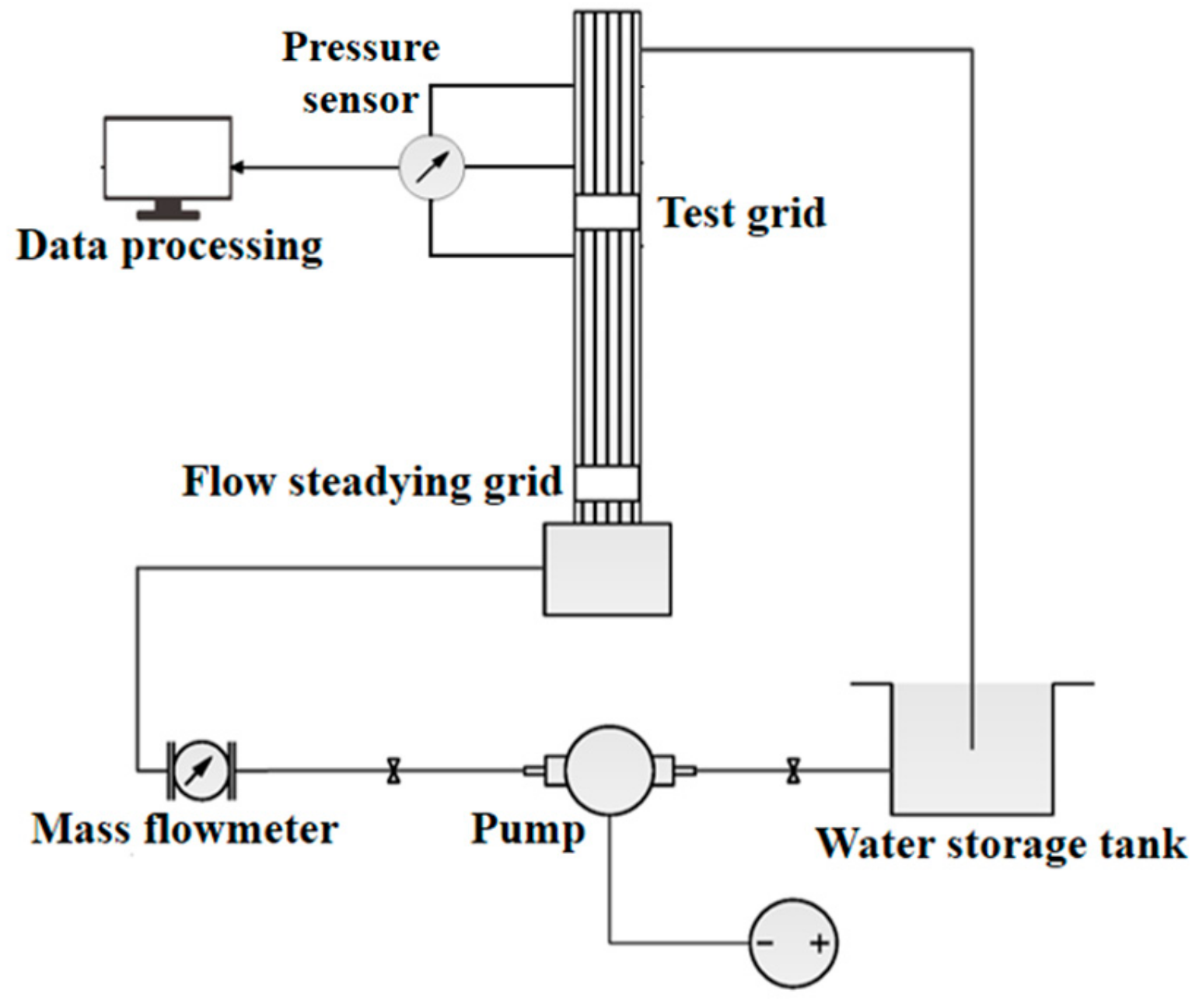
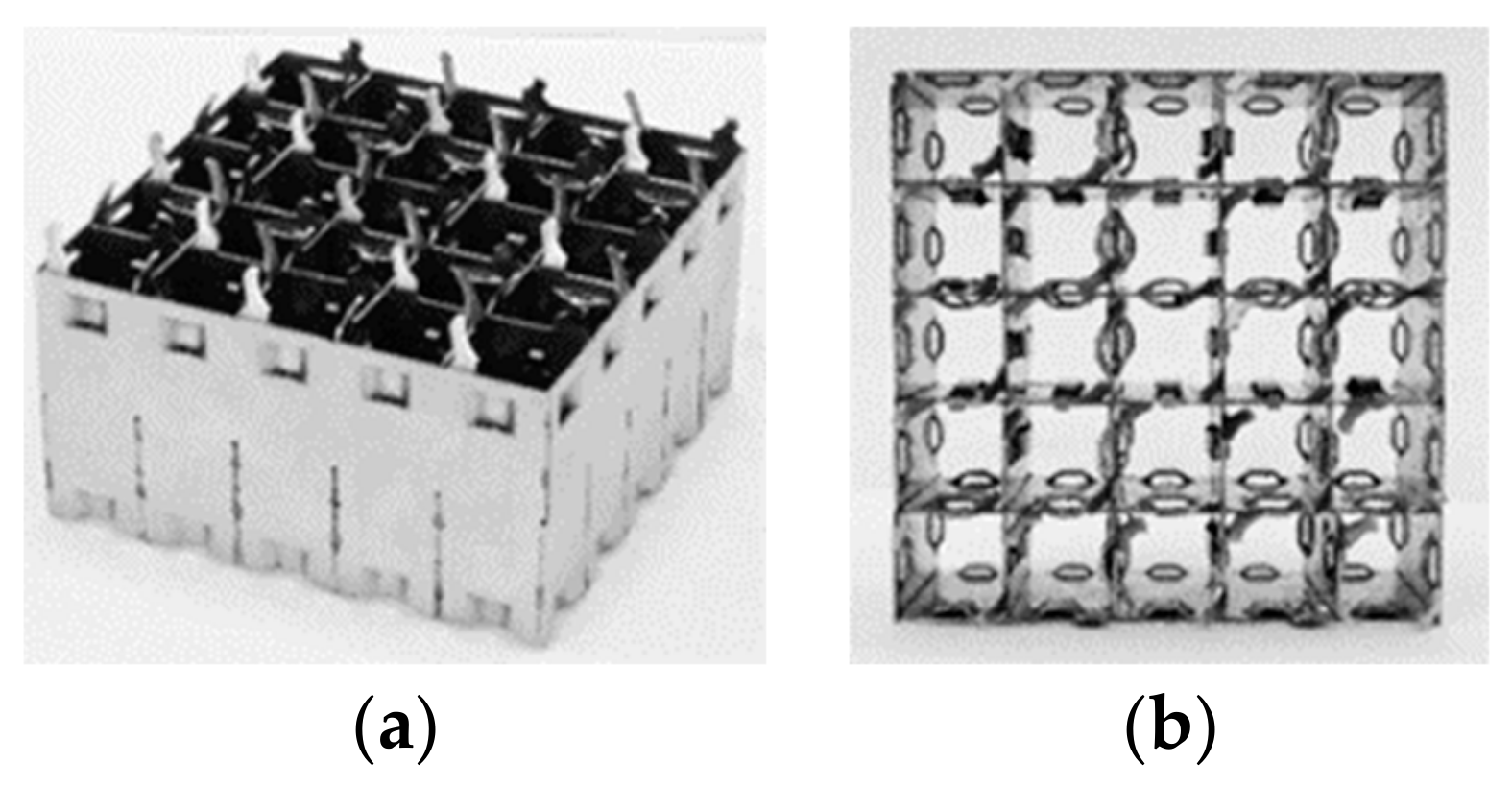


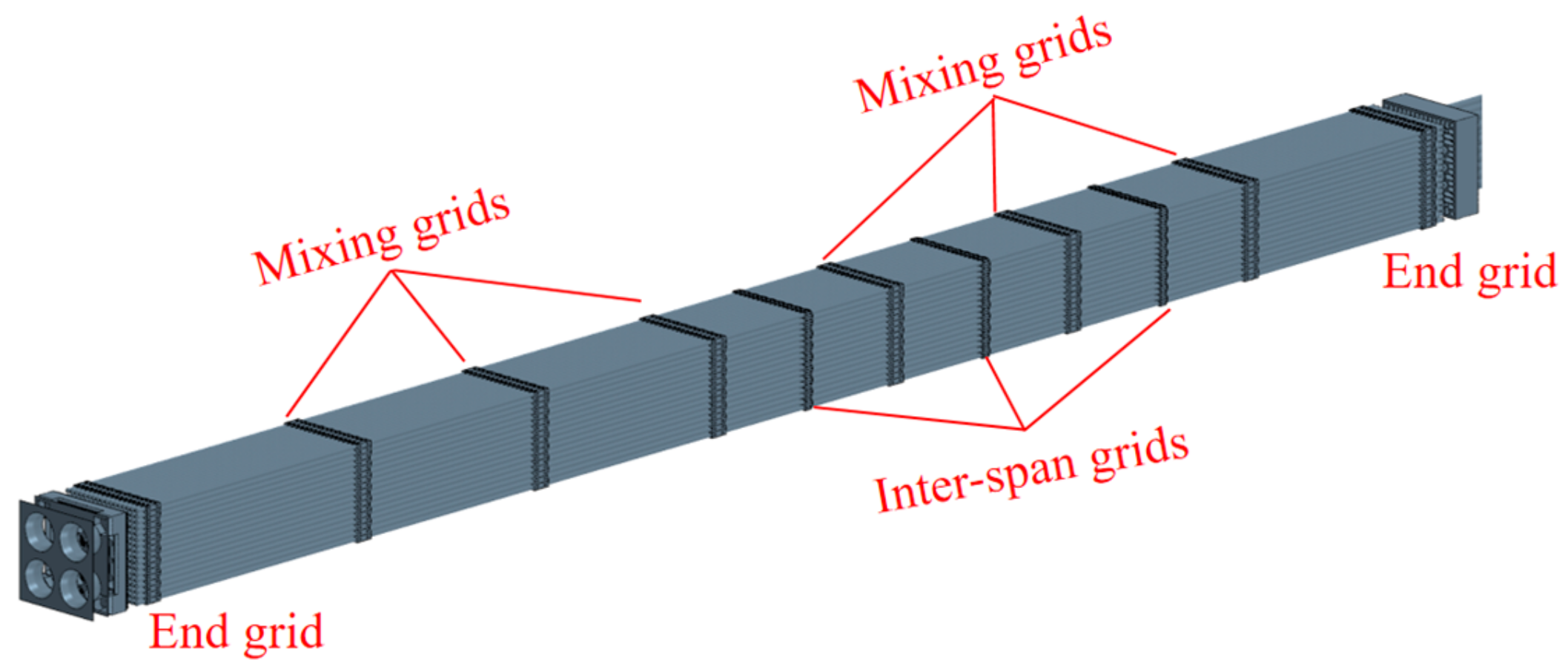

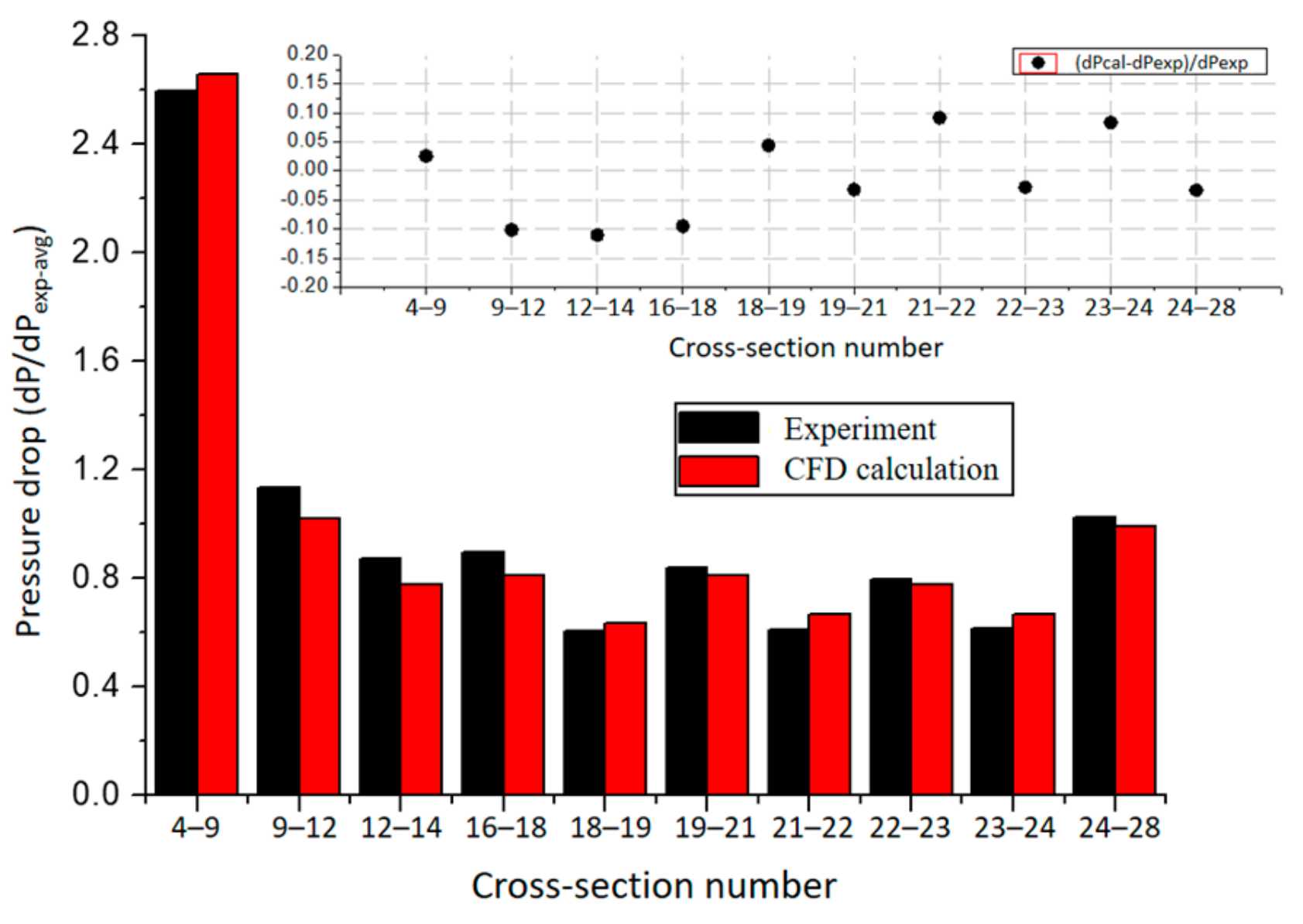
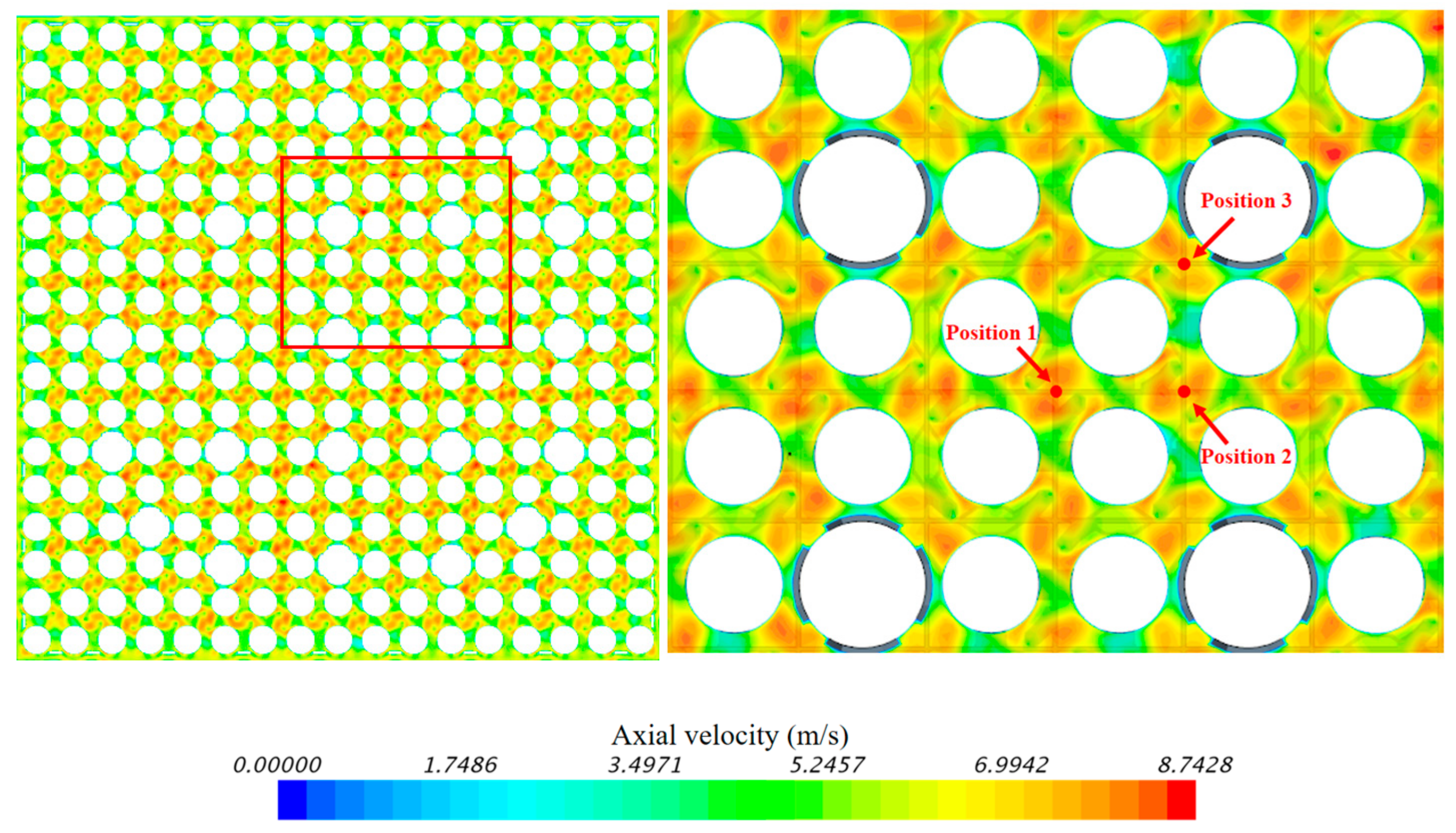

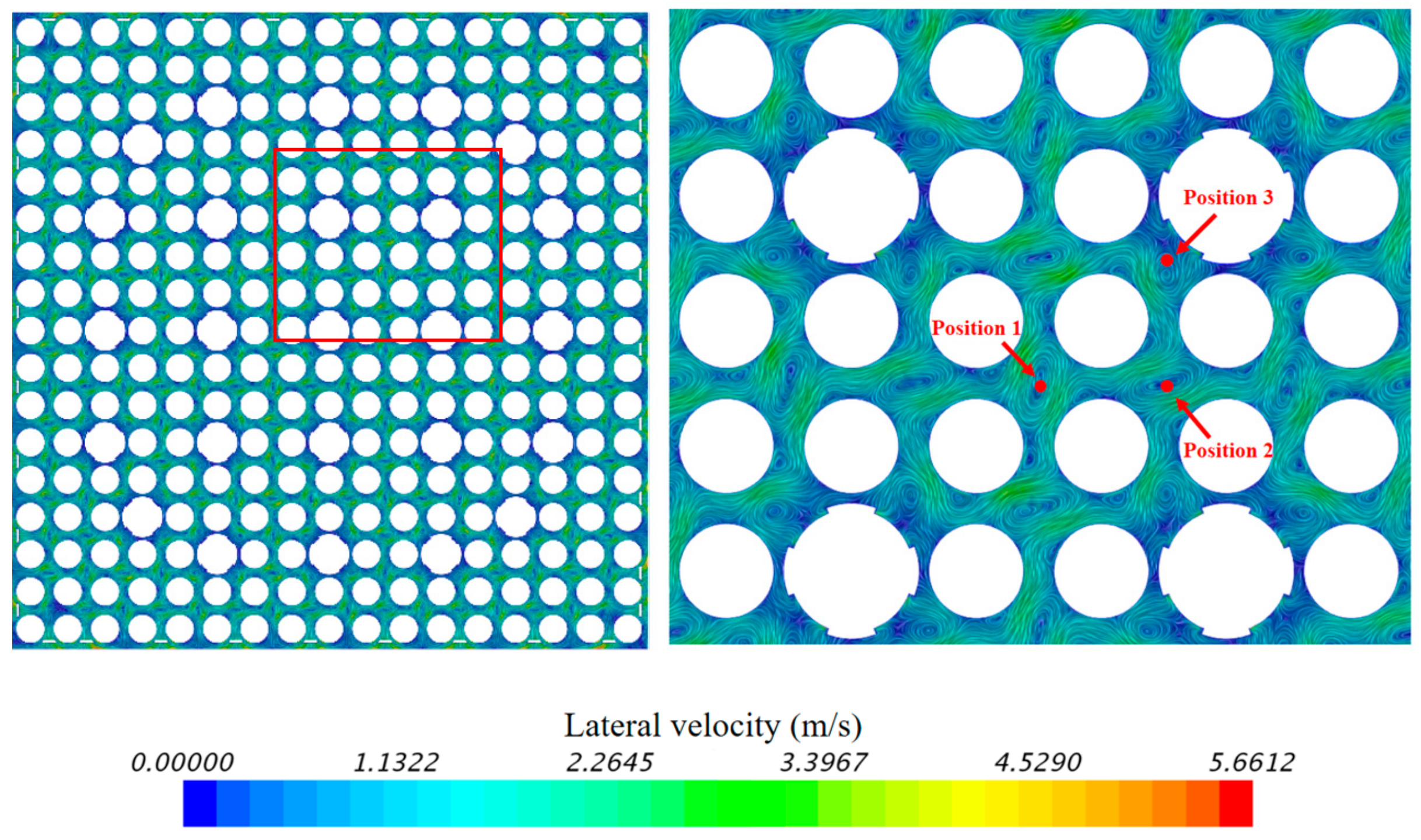



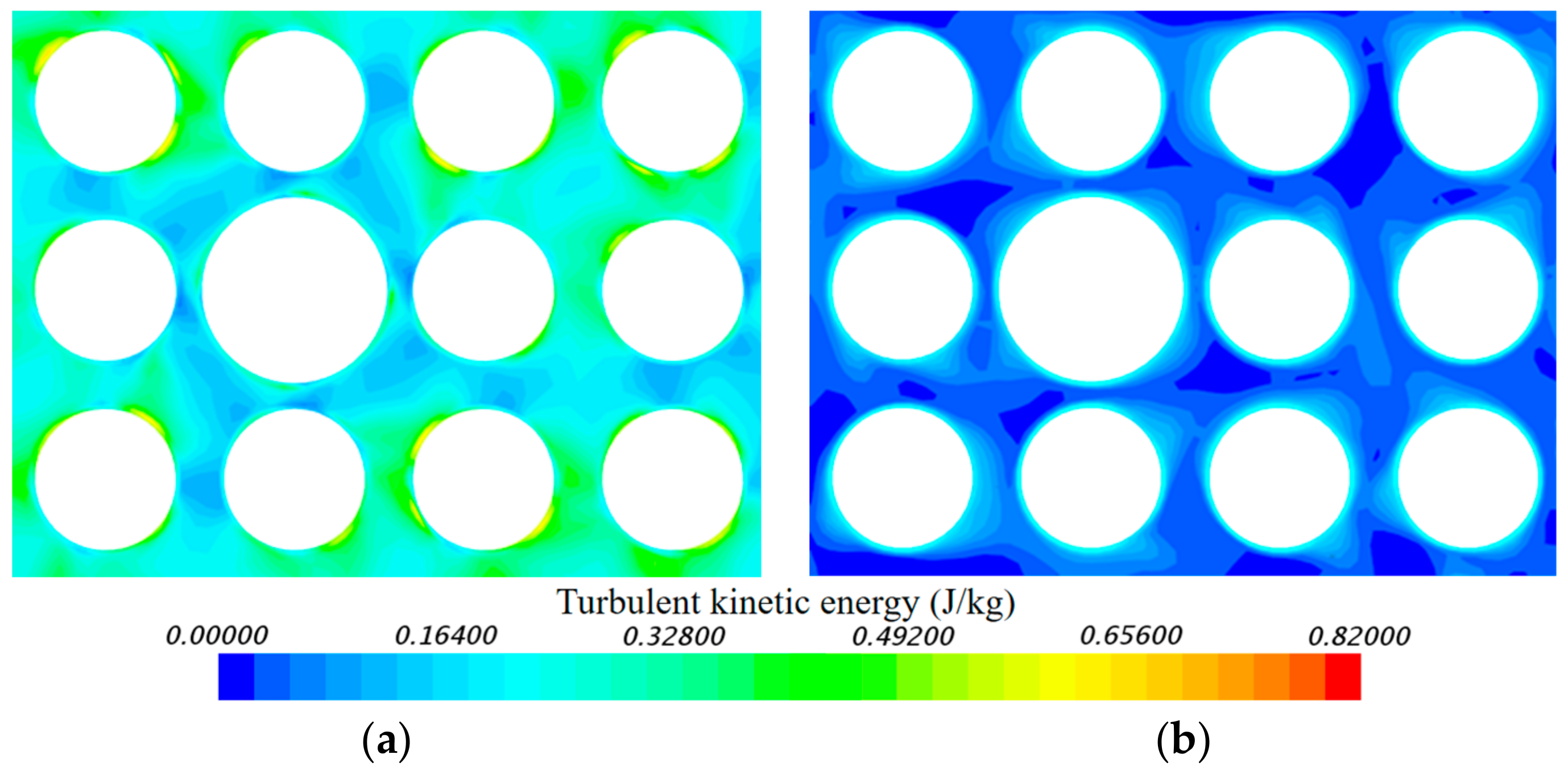
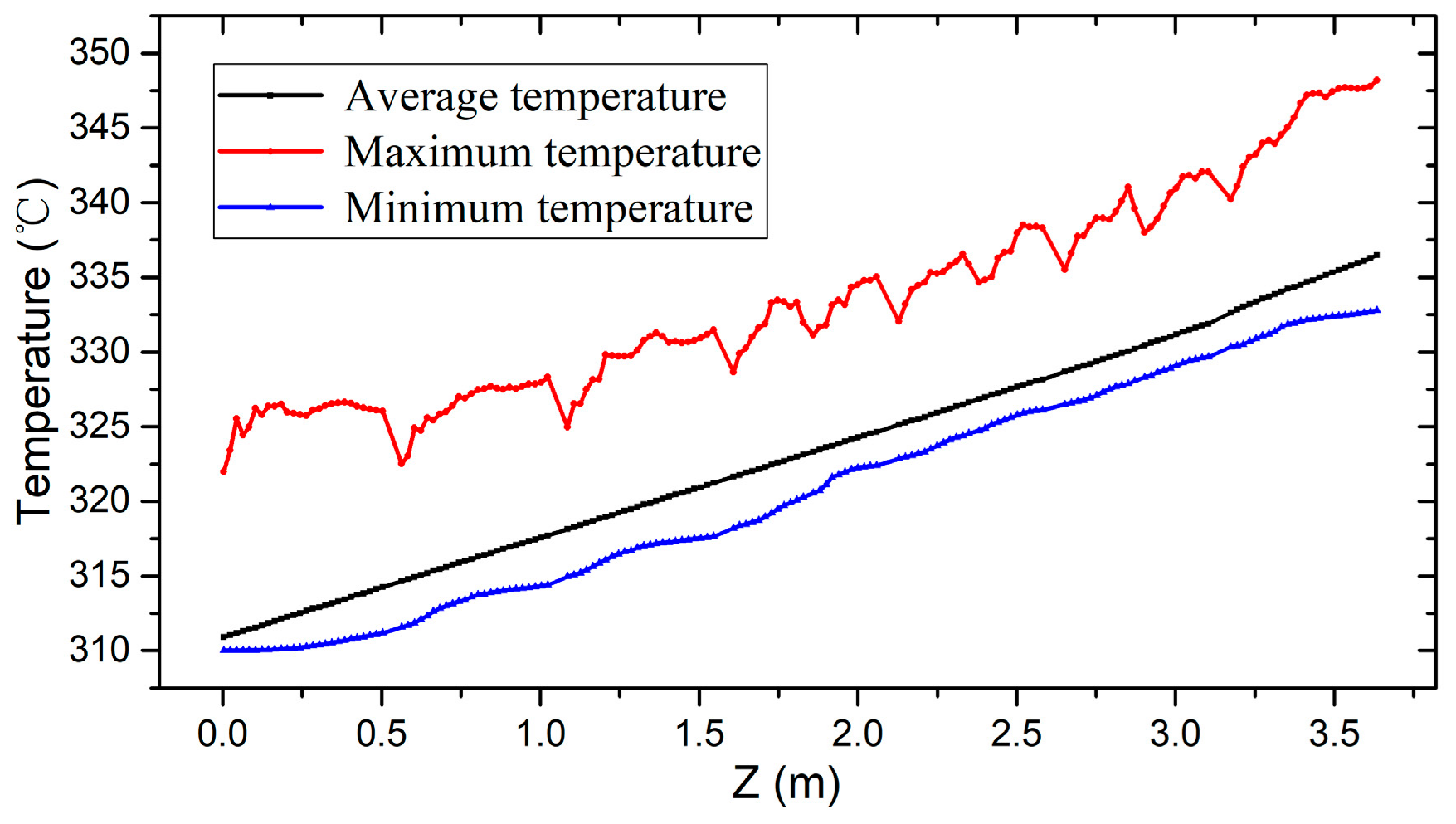
| No. | Base Size (mm) | Min Size at Grid (mm) | First Height of Prism (mm) | Ratio | Prism Layers | Mesh Number |
|---|---|---|---|---|---|---|
| 1 | 2 | 0.2 | 0.1 | 1.2 | 3 | 17.17 × 106 |
| 2 | 4 | 0.4 | 0.05 | 1.2 | 3 | 8.95 × 106 |
| 3 | 4 | 0.4 | 0.075 | 1.2 | 3 | 8.82 × 106 |
| 4 | 4 | 0.4 | 0.1 | 1.2 | 3 | 8.69 × 106 |
| 5 | 8 | 0.8 | 0.1 | 1.2 | 3 | 3.71 × 106 |
| Position | Parameter | Value | |||||
|---|---|---|---|---|---|---|---|
| Inlet | Mass flow (t/h) | 5.07 | 6.16 | 7.20 | 8.23 | 9.31 | 10.96 |
| Reynolds number | 6510 | 7910 | 9246 | 10,568 | 11,955 | 14,074 | |
| Outlet | Relative pressure (Pa) | 0 (Reference-pressure was 101,325 Pa) | |||||
| Spacer Grid | No slip wall | ||||||
| Wall | No slip wall | ||||||
| Type | Quantity |
|---|---|
| Cells | 193,023,023 |
| Interior Faces | 920,902,717 |
| Vertices | 701,831,537 |
© 2020 by the authors. Licensee MDPI, Basel, Switzerland. This article is an open access article distributed under the terms and conditions of the Creative Commons Attribution (CC BY) license (http://creativecommons.org/licenses/by/4.0/).
Share and Cite
Tian, Z.; Yang, L.; Han, S.; Yuan, X.; Lu, H.; Li, S.; Liu, L. Numerical Investigation on the Flow Characteristics in a 17 × 17 Full-Scale Fuel Assembly. Energies 2020, 13, 397. https://doi.org/10.3390/en13020397
Tian Z, Yang L, Han S, Yuan X, Lu H, Li S, Liu L. Numerical Investigation on the Flow Characteristics in a 17 × 17 Full-Scale Fuel Assembly. Energies. 2020; 13(2):397. https://doi.org/10.3390/en13020397
Chicago/Turabian StyleTian, Zihao, Lixin Yang, Shuang Han, Xiaofei Yuan, Hongyan Lu, Songwei Li, and Luguo Liu. 2020. "Numerical Investigation on the Flow Characteristics in a 17 × 17 Full-Scale Fuel Assembly" Energies 13, no. 2: 397. https://doi.org/10.3390/en13020397
APA StyleTian, Z., Yang, L., Han, S., Yuan, X., Lu, H., Li, S., & Liu, L. (2020). Numerical Investigation on the Flow Characteristics in a 17 × 17 Full-Scale Fuel Assembly. Energies, 13(2), 397. https://doi.org/10.3390/en13020397





